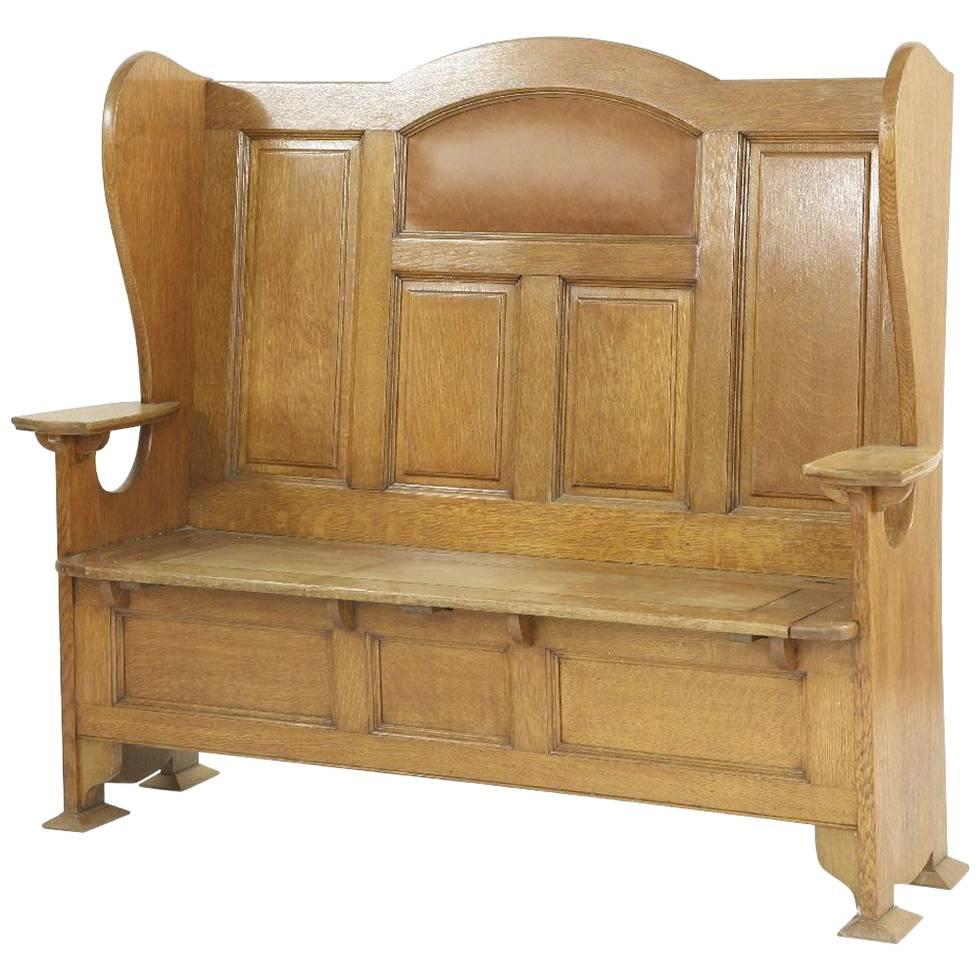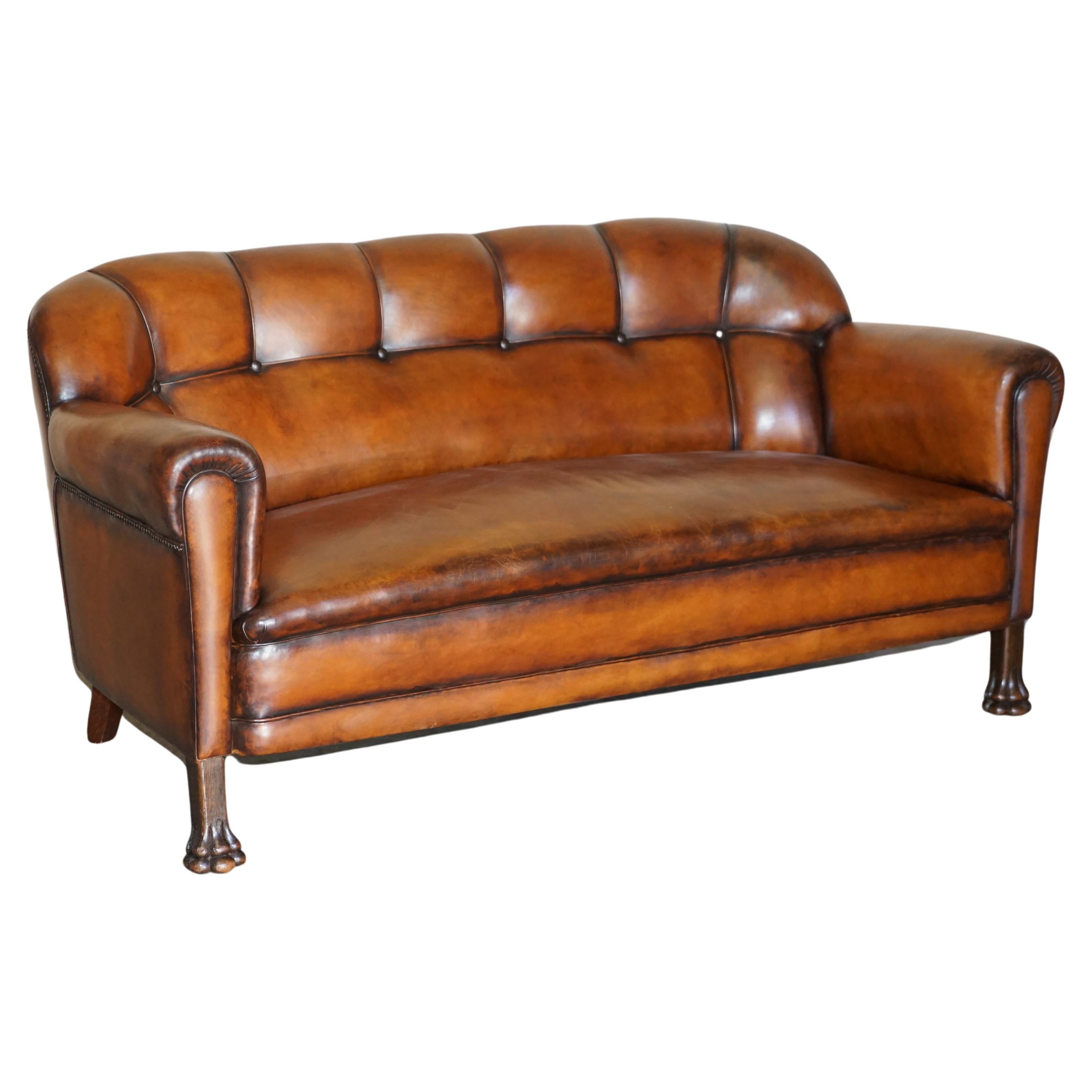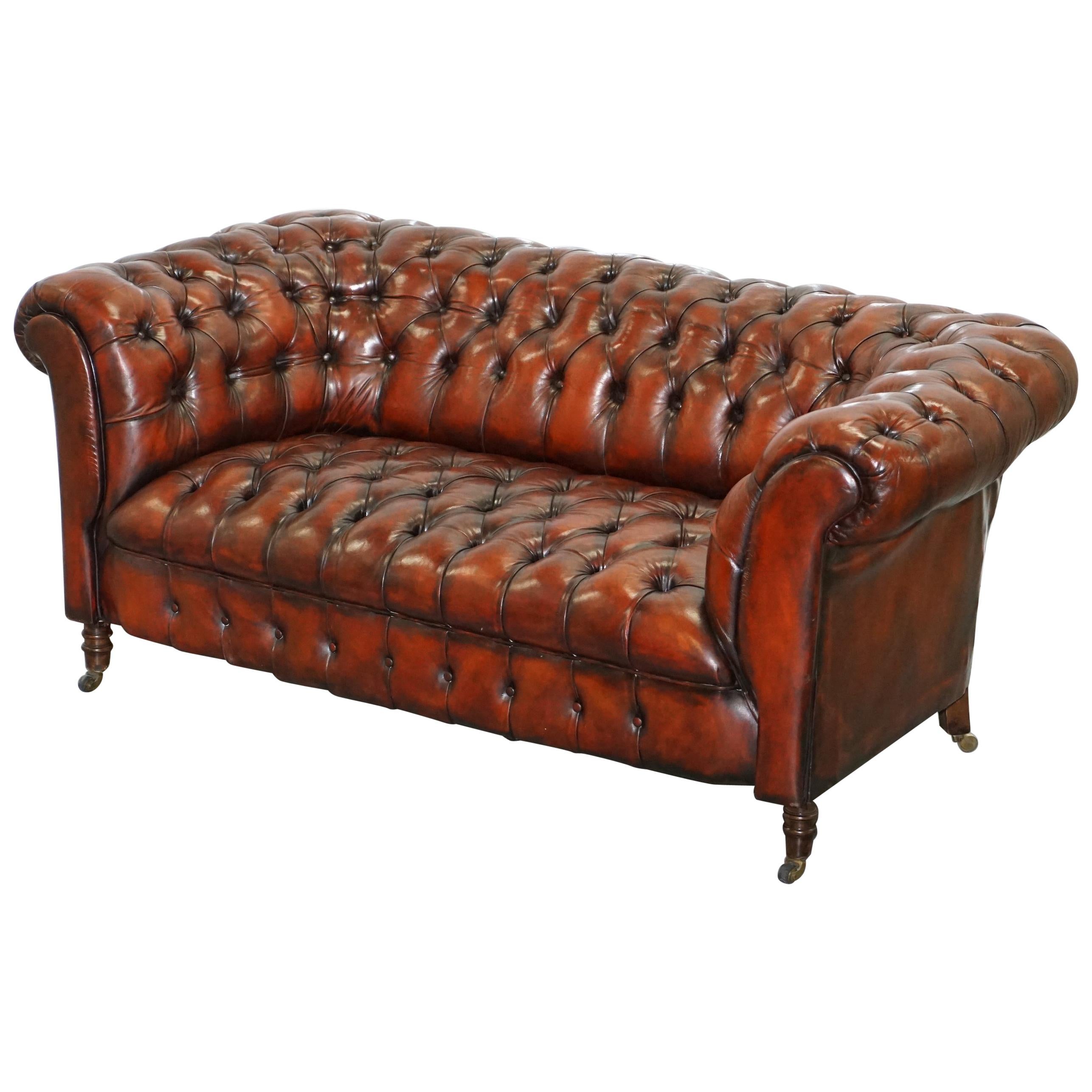Items Similar to Exhibition Quality Wylie & Lochhead 1860 Glasgow Chesterfield Brown Leather Sofa
Want more images or videos?
Request additional images or videos from the seller
1 of 20
Exhibition Quality Wylie & Lochhead 1860 Glasgow Chesterfield Brown Leather Sofa
About the Item
We are delighted to offer for sale this Exhibition quality Wylie & Lochhead of Glasgow circa 1860 fully restored Hand dyed brown leather Chesterfield sofa
This piece is absolutely sublime, made by the genius’s that were Wylie & Lochhead. The frame is what’s known as a show frame, they were made for Exhibition’s to show off the skill of the cabinet makers, this one manages to be ornate and elaborate whilst subtle and sophisticated at the same time. It is hand carved in oak, the legs are turned to the front and curved to the rear with the inside back left leg fully stamped and serial numbered. The leather is thick cattle hide, the seat platform a traditional coil sprung affair
In terms of the condition the sofa has been fully restored, the leather has been washed back then hand dyed this glorious Bordeaux brown colour that is exclusive to my leather polishers, the oak frame, lightly washed back and French polished whilst being sure to maintain all the original patina and character
There will be age and use related patina marks as you would hope to find and expect on a 160+ year old piece
Dimensions
Height:- 82.5cm
Width:- 191.5cm
Depth:- 71.5cm
Seat height:- 41cm
Please note all measurements are taken at the widest point.
Wylie & Lochhead Glasgow, Scotland; furniture makers & retailers (fl.1829-1957)
Robert Wylie began business on his own account in Glasgow in 1817 and in 1828 moved to 80 Trongate, established as an upholsterer and hair and feather merchant. William Lochhead started work in his father’s post-hiring, undertaking and cabinet-making business. Wylie married Margaret Downie in 1824 and Lochhead married her sister, Janet, the following year. In 1829 Wylie and Lochhead formed a partnership as general upholsterers, furnishers and funeral undertakers, and took second floor premises at 164 Trongate.
Their early success was largely due to high demand for undertakers following the cholera epidemic of 1832 and, with this increased reputation and an eye for new styles and technical developments, their stock of furnishings expanded. The accounts for 1834 showed an annual turnover of £4,438 but by 1844, with two more stores at Saltmarket and Bell Street, the turnover had increased to £30,613. In the 1870s the company was the first of the Glasgow furnishers to specialise in ship and yacht interiors. By the 1880s they had showrooms, factories and warehouses throughout Glasgow (feather works in Dorset Street, upholstery workshop at Mitchell and Unions Streets, paper-staining in Whiteinch and a large cabinet-making workshop in Kent Road with an adjacent carving, gilding and plate-glass silvering works).
Branches were later established in London and Manchester and they had network of agents and buyers throughout Europe and the Empire. In 1882 Wylie and Lochhead employed 1700 people and on 20 August 1883 they were registered as a limited company. George Logan, apprentice cabinet maker in Beith, joined the Wylie & Lochhead in 1882 as a trainee and stayed until 1937 by which time he was chief designer. Ernest Archibald Taylor was a draughtsman at Scott & Co. Ltd, the Clyde shipyard, before starting with Wylie & Lochhead in 1893/94 also as a trainee designer. As well as training their own apprentices, they employed students from the Glasgow Schools of Art and Technical Colleges. Among these were Jessie King, David Gow and John Ednie. Many of their designers taught at the Glasgow School of Art and the Glasgow and West of Scotland Technical College and acted as local examiners; there was a Wylie & Lochhead prize for furniture design.
The Glasgow International Exhibition of 1901 was an opportunity to show their work with great panache. The exterior of the pavilion was designed by David Gow and the inside by George Logan, John Ednie and E.A. Taylor, who were each given a specific room. The Cabinet Maker and Art Furnisher, August 1901, described the Wylie & Lochhead pavilion as ‘unquestionably the most important furnishing display’ (illus. The Decorative Arts Society 1850-1932 (1985), pp. 8, 10 & 11). They made most of the furnishings for the Exhibition themselves, with carpets specially woven by Alexander Morton & Co. and stained glass made by Hugh MacCullouch & Co. A mahogany bookcase, with stained and leaded glass, mother of pearl, white metal mounts and leather inserts, which was designed in 1900 by Logan for the Rossetti library at the 1901 Exhibition, is now at the V&A Dundee.
Where appropriate their designers incorporated work of other artists and craftsmen in their schemes including cushions embroidered by Ann MacBeth, prints by Rossetti, a large Burne-Jones tapestry and appliqué work in the library and bedroom by Godfrey Blount. A clock designed by C. R. Ashbee was displayed in the Royal Reception Rooms at the Exhibition. However, Wylie & Lochhead was keen to show a brand image and not promote individual designers, so its souvenir booklet stressed that ‘The entire exhibit can be reproduced, if desired, in a simpler or more elaborate type of the same character’.
The show led to a prestigious commission from Margaret MacConnachie and her husband Robert Hay Coats to furnish, to Taylor’s designs, their new house at 32 Radnor Road, Handsworth, near Birmingham. A more extensive commission which included panelling, fitted furniture and elaborate stained glass, was for the Pollokshields town house of William Weir, later Lord Weir of Cathcart, for which Taylor won a medal and diploma at the 1902 Turin exhibition. The entire 1901 pavilion was selected for display in an exhibition of British Arts and Crafts held in 1902 at the Imparmüvészeti Musum in Budapest and the host museum acquired various items from their display.
At the Turin International Exhibition of 1902 their designers, Logan, Ednie and Taylor, were allowed to exhibit in their own right. Logan exhibited the ‘Rose Screen’, a three-panel screen executed by Wylie & Lochhead, and described in Studio Magazine, 1902 p.99 as ‘a novel treatment of wood, silver, precious stones, and chains of silver strung with pearls and turquoises, the central panel containing a framed drawing by Jessie M King, of The Princess of the Red Rose; altogether a most dainty production’. The screen and a matching desk were purchased by Walter S. Strang, a Scotsman who immigrated to Australia in 1890s, in 1929. Eight years later the desk was destroyed in a fire but the screen was restored and then exhibited in The Folding Image: Screens by Western Artists of the Nineteenth and Twentieth Centuries, National Gallery Of Art, Washington DC in 1984 and is in the permanent collection of the Glasgow Museums Collection (E.1986.52).
In addition to exhibition furniture they produced less elaborate ranges of furniture under such labels as ‘Arts and Crafts’, ‘Quaint’, ‘New Art’ and ‘Artistic’, with some pieces available in a variety of woods and colours. The ‘Saxon’ and other Windsor chairs were purchased from High Wycombe by Wylie & Lochhead at this time. An example of a chair inlaid with woods and mother of pearl featured in their catalogue of early 20th century is illustrated in Agius (1978), p.122.
By 1908 Ednie and Taylor had left Wylie & Lochhead and by 1916 further additions to the Glasgow properties had been made. At Cleveland Street they had five floors of almost 21,000 square feet, the Kent Road workshop comprised almost 40,000 square feet and they had workshops or outlets at Belgrave (now Beltane) Street, Graeme (now Bell Street) and College and High Street. Stores opened in Manchester and in Bloomsbury London, the latter still trading as late as 1930, while land had been acquired in the Natal.
They held royal warrants as cabinet makers and upholsterers to Queen Victoria, the Prince of Wales, King Edward VII, King George V and King George VI. For the International Exhibitions in 1888, 1901, 1911 and 1938 the Royal Suites were furnished by Wylie and Lochhead. At the 1888 exhibition the suite comprised two retiring rooms and a dining room; the latter featured dark coloured ‘Scottish Baronial’ oak furniture (illus. Kinchin and Kinchin (1988), p. 23) and now at the Kelvingrove Art Gallery, Glasgow. They were also involved in the interiors of the Royal Yacht Britannia, the Queen Mary and Queen Elizabeth liners. Also supplied cabinet work at Australia House, London; The British Museum; Lloyd’s Shipping Boardroom; Skibo Castle and Lloyd’s Bank in the early 20th century.
They continued to exhibit and Robert Wylie, as a member of the board of the Scottish Furniture Manufacturers’ Association, in January 1929 responded positively the idea of the Glasgow School of Art receiving a prize for Furniture Design. In 1947 they held The Swedish Home Exhibition at their Buchanan Street, which was sponsored by the Council of Industrial Design and in 1951 under Scottish Furniture Manufacturers Ltd’s banner their furniture was chosen by the Council of Industrial Design Selection Committee and displayed at South Bank's Festival of Britain. Their 1951 sales catalogue illustrated the Cintique Chair, covered in ambia leather, designed by Ernest Race. In May 1956 a new Edinburgh store was opened but by this time Robert Wylie was in negotiations to sell. Discussions were held first with Waring and Gillow and then with Great Universal Stores but finally in September 1957 a formal announcement was made confirming the sale of Wylie and Lochhead to the House of Fraser.
Sources: Agius, British Furniture 1880-1915 (1978; Kinchin, ‘The Wylie & Lochhead Style’, The Decorative Arts Society 1850-1932 (1985); Kinchin and Kinchin, Glasgow Great Exhibitions 1888, 1901, 1911, 1838, 1988 (1988); Komanecky, ‘The Restoration of George Logan’s Rose Screen’, The Decorative Arts Society 1850 to the Present (1985); Cooper, ‘Post-War Scottish Furniture Design. Scottish Furniture Manufacturers Ltd’, The Decorative Arts Society 1850 to the Present (2009); Hooper, ‘Stockholm to Buchanan Street – Wylie and Lochhead and the New Style’, The Journal of the Decorative Arts Society 1850 to the Present (2013); Wallis, ‘A Hand-List of the Handley-Read Collection’, The Decorative Arts Society 1850 to the Present (2016).
This item is available for collection from our Pulborough warehouses.
Condition
Please view the very detailed pictures as they form part of the description pertaining to the condition. Please also ask any questions before you bid and not after, all of our items are sold as seen and as listed.
Please note vintage period and original items such as leather seating will always have natural patina in the form of creasing and wear, we recommend annual waxing to ensure no moisture is lost, also hand dyed leather is not recommended to sit in direct sunlight for prolonged periods of time as it will dry out and fade.
- Creator:Wylie & Lochhead (Maker)
- Dimensions:Height: 32.49 in (82.5 cm)Width: 75.4 in (191.5 cm)Depth: 28.15 in (71.5 cm)Seat Height: 16.15 in (41 cm)
- Style:High Victorian (Of the Period)
- Materials and Techniques:
- Place of Origin:
- Period:
- Date of Manufacture:1860
- Condition:Refinished. Wear consistent with age and use.
- Seller Location:GB
- Reference Number:1stDibs: LU2823326955892
About the Seller
4.6
Platinum Seller
These expertly vetted sellers are 1stDibs' most experienced sellers and are rated highest by our customers.
Established in 2012
1stDibs seller since 2017
1,711 sales on 1stDibs
Typical response time: <1 hour
- ShippingRetrieving quote...Ships From: United Kingdom
- Return PolicyA return for this item may be initiated within 14 days of delivery.
More From This SellerView All
- Restored Victorian 1890 Cornelius V. Smith Stamp Chesterfield Leather Sofa BrownBy Cornelius V. SmithLocated in GBWe are delighted to offer for sale this lovely rare original fully restored Victorian 1890 Cornelius V Smith Stamped aged whiskey brown leather Chest...Category
Antique 1890s English High Victorian Settees
MaterialsLeather, Hardwood
- Fine Antique Victorian Brown Leather Chesterfield Sofa Oak Lions Hairy Paw FeetBy ChesterfieldLocated in GBWe are delighted to offer for sale this circa 1860-1880 fully restored original Swedish aged brown leather Chesterfield fully sprung sofa with hand carved ...Category
Antique 1860s English High Victorian Sofas
MaterialsLeather
- Small Restored Chesterfield Victorian Whisky Brown Leather SofaBy ChesterfieldLocated in GBWe are delighted to offer for sale this stunning fully restored Victorian circa 1880 hand dyed Chesterfield two-seat sofa with fully but...Category
Antique 19th Century English Victorian Sofas
MaterialsLeather, Mahogany
- Antique Victorian Chesterfield Tufted Brown Leather Sofa Feather Filled CushionsBy ChesterfieldLocated in GBWe are delighted to offer this stunning fully restored Victorian hand dyed cigar brown leather Chesterfield tufted club sofa with feather filled cushions This sofa is as rare as t...Category
Antique 19th Century English Victorian Sofas
MaterialsLeather, Hardwood
- Stunning Antique Fully Restored Cigar Brown Leather Chesterfield Sofa WalnutBy ChesterfieldLocated in GBWe are delighted to offer for sale this exceptionally rare original antique circa 1900 cigar brown leather Chesterfield club sofa in restored condition with feather filled cushions a...Category
Antique Early 1900s English Late Victorian Sofas
MaterialsLeather, Walnut
- Victorian Serpentine Hand Dyed Restored Whisky Brown Leather Chesterfield SofaBy ChesterfieldLocated in GBWe are delighted to offer for sale this stunning fully restored Victorian hand dyed cigar brown leather serpentine fronted Chesterfield club sofa This sofa is as rare as they come...Category
Antique 19th Century English Victorian Sofas
MaterialsLeather
You May Also Like
- Wylie & Lochhead Style of M H Baillie Scott An Arts & Crafts Glasgow Oak SettleBy Mackay Hugh Baillie Scott, Wylie & LochheadLocated in London, GBWylie and Lochhead, after a design by M H Baillie Scott. A good Arts & Crafts Glasgow School panelled oak settle with central upholstered leather panel, ...Category
Antique 1890s Scottish Arts and Crafts Benches
MaterialsLeather, Oak
- Modern Leather Chesterfield SofaLocated in Westwood, NJA Modern leather Chesterfield sofa. A take on the traditional 19th century English design with squared arms and backrest. The arms and backrest tufted with two comfort down seat ...Category
21st Century and Contemporary North American Chesterfield Sofas
MaterialsLeather, Maple
- Leather 4 Seater Chesterfield SofaLocated in Westwood, NJA classic long leather 4 seater Chesterfield sofa. The unusual long tufted chesterfield sofa is ideal for a long entry hall, living room, a hotel l...Category
21st Century and Contemporary American Chesterfield Sofas
MaterialsLeather, Wood
- Antiqued Chesterfield Leather SofaLocated in Westwood, NJA Classic antiqued Chesterfield leather sofa. This beautiful hand-rubbed and antiqued leather Chesterfield sofa is beautifully crafte...Category
21st Century and Contemporary American Chesterfield Sofas
MaterialsLeather
- Vintage English Chesterfield Leather Tufted Sofa Brown Terra Cotta Mid CenturyLocated in Tyler, TXTIMELESS Vintage Mid-Century English Leather Tufted Seat CHESTERFIELD 3-Seat Sofa Brown/Terra Cotta PERFECT ICONIC look for a gentleman's office, study, library, or cigar lounge~~fu...Category
Mid-20th Century English Chesterfield Sofas
MaterialsLeather
- Vintage Cigar Brown Hand Dyed Leather Camel Back Chesterfield Two Seater SofaLocated in Pulborough, GBWe are excited to present this vintage cigar brown hand-dyed leather camel back chesterfield two seater sofa. A very classic design with a lovely...Category
20th Century British Sofas
MaterialsBrass
Recently Viewed
View AllMore Ways To Browse
Chain Woven Leather
Dining Couches
Dining Couch
The Great Exhibition Furniture
Brown Chain Leather
Sofa For Dining
Desk Couch
Sisters Used Furniture
Dc Used Furniture
Victorian Exhibition
Brown Square Plate
Various Antique Furniture Items
Hand Carved Antique Sofa
Antique Couch Hand Carved
Antique Furniture Washington
French Seating Sofas And Chairs
Used Trade Show Furniture
Couches Print





